How to make Manhattan-style Fermented Pickles with Garlic and Dill! An easy step-by-step guide to making the most flavorful, crunchy, tangy pickles full of healthy probiotics with only 20 minutes of hands-on time! The pickle brine is like a “tonic” -drink a shot daily to support a healthy gut! Video.
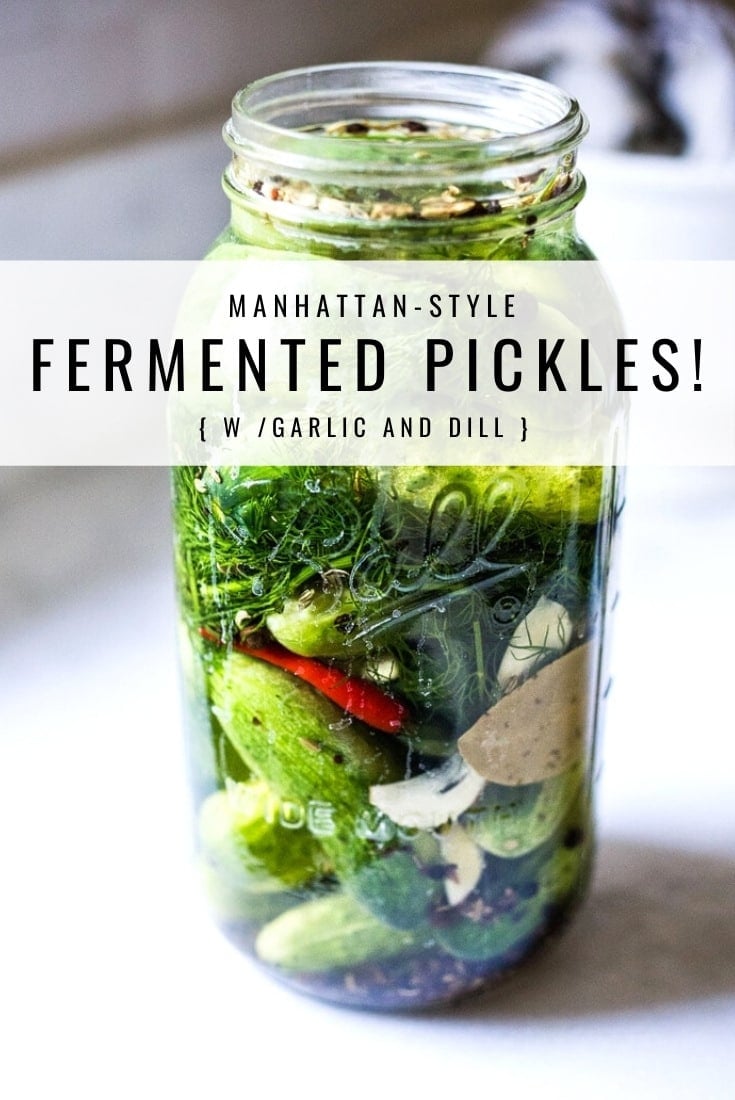
What happens when people open their hearts? They get better. ~Haruki Murakami
I’m excited to share this easy recipe for Fermented Pickles with you! If you are a crunchy pickle lover like me, you will be in heaven. Seriously, these are the best! These Manhattan-style “half-sour” fermented dill pickles are crispy, crunchy, flavorful, and oh-so alive!
Fermented in a salt brine, rather than vinegar, they get their delicious tanginess from light fermentation rather than vinegar.
Full of healthy, gut-healing, immunity-boosting probiotics these little guys are perfect as a low-calorie snack, or sliced and added to sandwiches or served as a tasty side.
Not only are they delicious and incredibly EASY to make, they are also incredibly good for us!
And as crazy as this may sound to some, the fizzy brine itself is like a healing tonic to me – I love to drink a shot of it- especially when I feel like my immunity needs a boost! So flavorful and totally energizing. Or try a Gin and Brine!
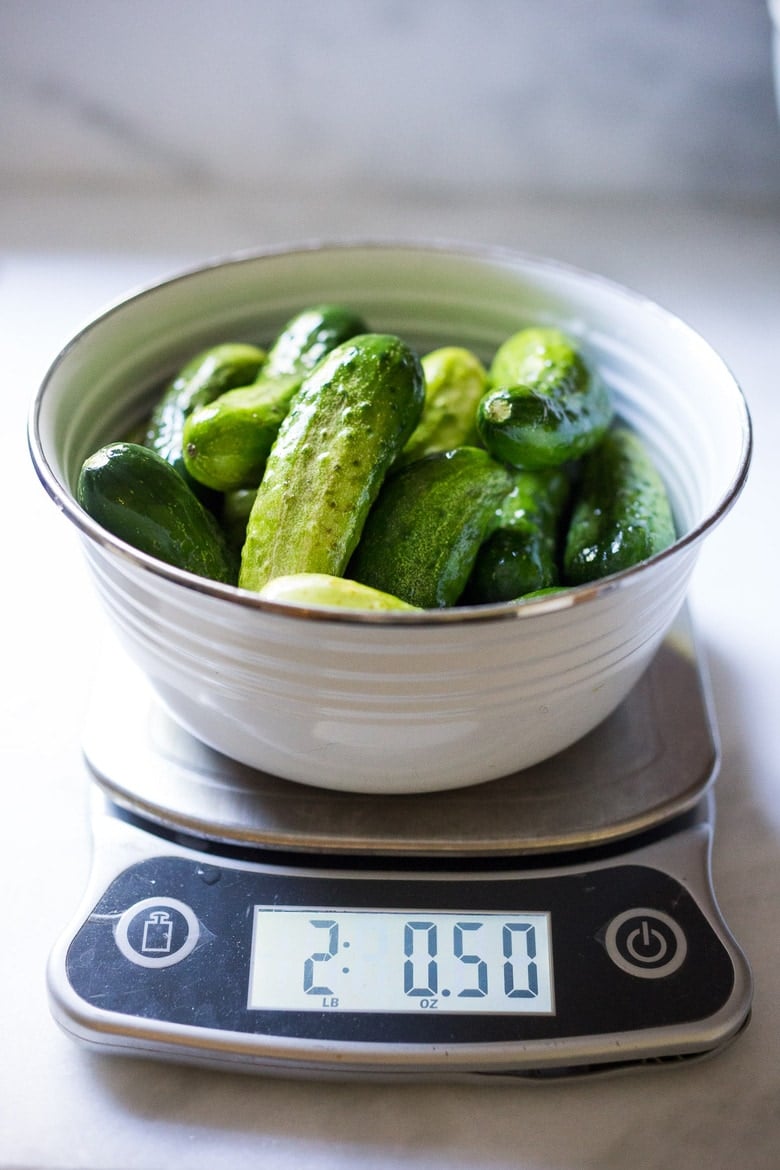
What you’ll need
- Pickling Cucumbers- Small and short (4 inches long) with thin bumpy skin, crisp texture, small seeds, a blocky shape and color gradient from light to dark. Varieties include Kirby, Calypso, Royal, Pickalot, National Picking, Adam Gherkin, Sassy, Eurika, Jackson, Boston Pickling, Northern Pickling… to name a few. You’ll need 2 lbs of “pickling cucumbers.” This recipe makes one large 1/2 gallon jar (or use two quart-sized jars) – a relatively small batch. Pickling cucumbers are most easily found at your local farmers’ market. Ask the farmers if they have “pickling cucumbers” they can help direct you to the right ones. Your pickles will only be as good as your cucumbers, so choose wisely! Make sure they are roughly the same size -about 4 inches long with 1 1/2-inch to 2-inch diameters – so they fit in the jar nicely and ferment at the same rate. I handpicked each one. They should be fresh and crisp with no soft spots.
- Salt-use fine sea salt, or fine Himalayan Pink salt
- Garlic and Onion – we load this up with 10-20 garlic cloves for the best flavor!
- Fresh Dill – use a big handful!
- Spices: Ground Turmeric ( adds fresh flavor) fennel seeds, mustard seeds, whole peppercorns, coriander seeds, whole allspice, dill seeds and celery seeds. Feel free to change or embellish! I added a couple of chilies for a little heat.
- Optional Tannic Acid: Bay leaves, grape leaves, oak leaves, or a couple of slices of fresh horseradish root. Cucumbers contain enzymes that soften them. To prevent this add a few bay leaves or a grape leaf to the jar.
- Two-Quart Mason Jar ( 8 cup mason jar)
- Fermentation weights
- Optional: Air lock, gasket, metal ring
How long does it take to ferment pickles?
These 3% Brined, half-sour crunchy pickles take 3-5 days of fermenting time.
The Brine: SALT TO WATER RATIO
- This recipe is a 3% salt water brine, which is considered “safe”. It equals 7 grams of salt per 1 cup of water. Or, 1 heaping teaspoon salt (1 1/4 teaspoon salt ) per 1 cup of water. This ratio allows one to drink the brine (like a shot) because it is not too salty and is designed for a shorter fermentation period ( 3-5 days). Crunchy, lightly fermented pickles!
- If you want a stronger brine for a longer ferment, feel free to go up to 4.5%. So for example, 3.5% Ratio= 9 grams of salt per 1 cup of water, 4.5% brine =10.8 grams of salt per 1 cup of water. For a 4.5% brine, half-sour pickles take 5-7 days, full sour pickles 14-21 days.
Fermented Pickles (step-by-step Instructions)
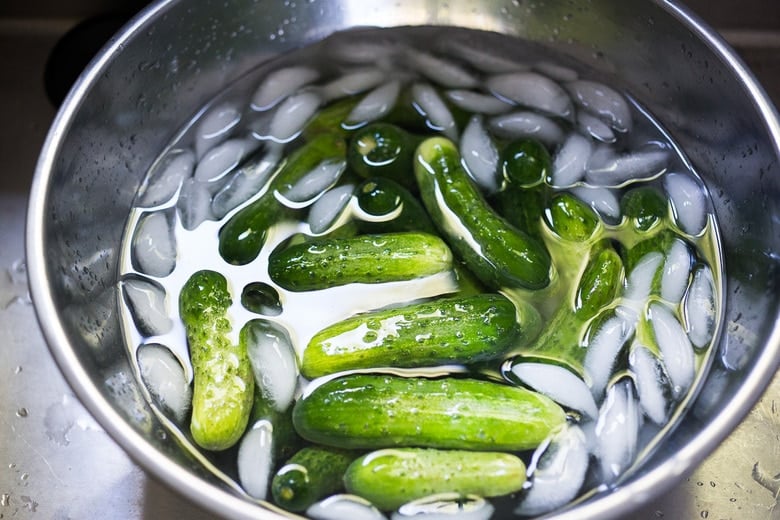
Step 1: Wash the cucumbers, slice off 1/16 inch of the blossom end, and soak them in an ice bath for 15-30 minutes to firm and crisp them up. There are enzymes in the blossom end that can make your pickles soft, so be sure to remove them.
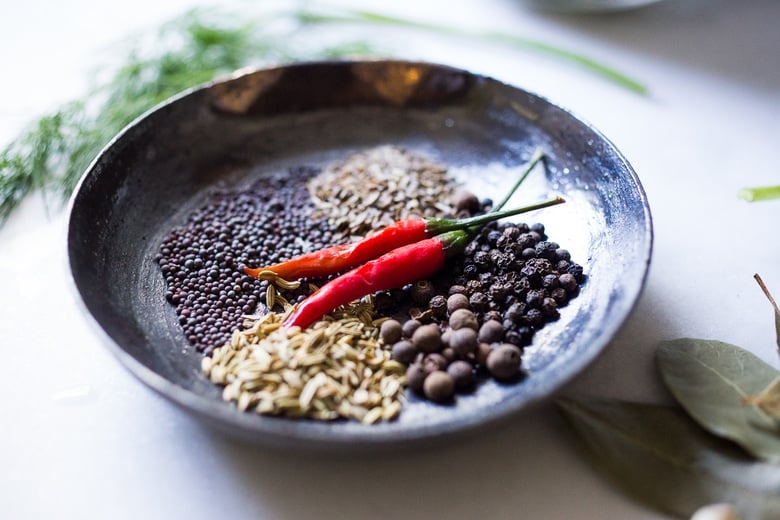
Step 2: Slice the garlic lengthwise and gather your spices.
Because these fermented pickles are left whole, you want the brine to be extra flavorful. I add a lot of garlic… 10-15 cloves, sometimes 20! Fermented Garlic is really good for the gut too!
Step 3: Place the spices on the bottom of the jar, then sliced garlic, fresh dill and bay leaves, and then add 2 layers of cucumbers, end on end, in a large two-quart jar (half-gallon). Press everything down.
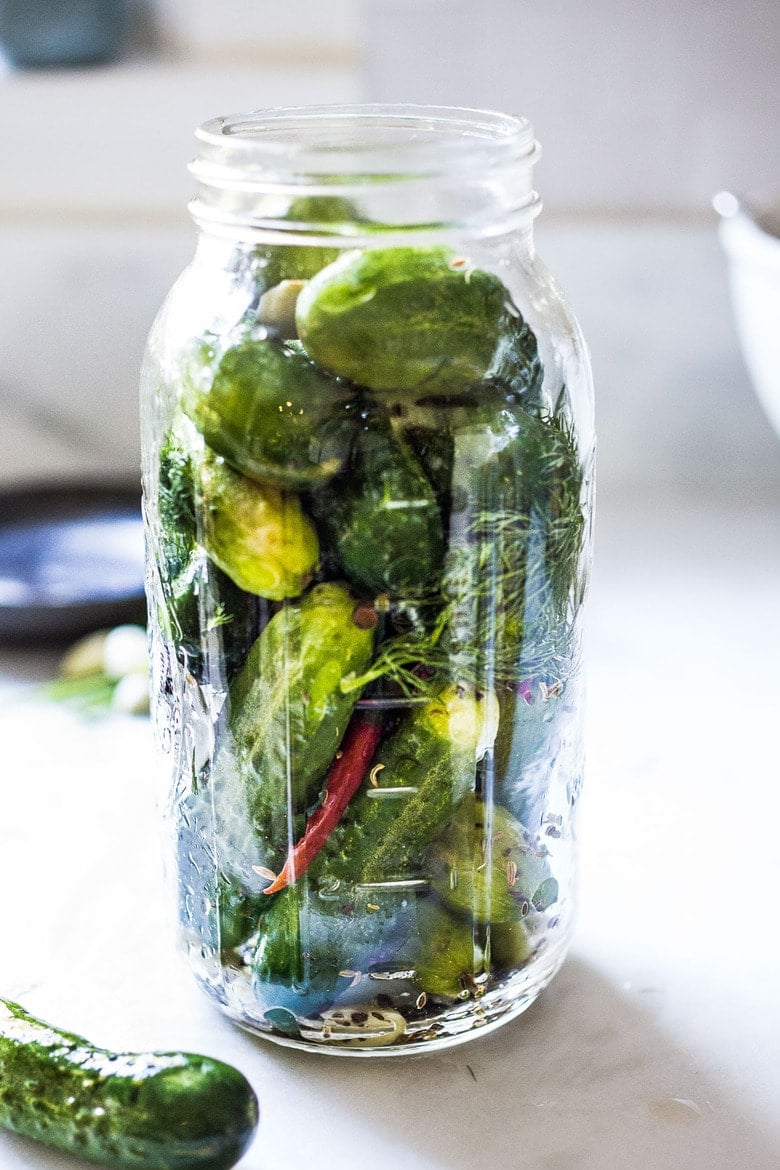
Step 4: Carefully measure and mix salt and water to create the 3% salt water brine- then pour this brine over the pickles leaving 1 1/2 inches of headroom.
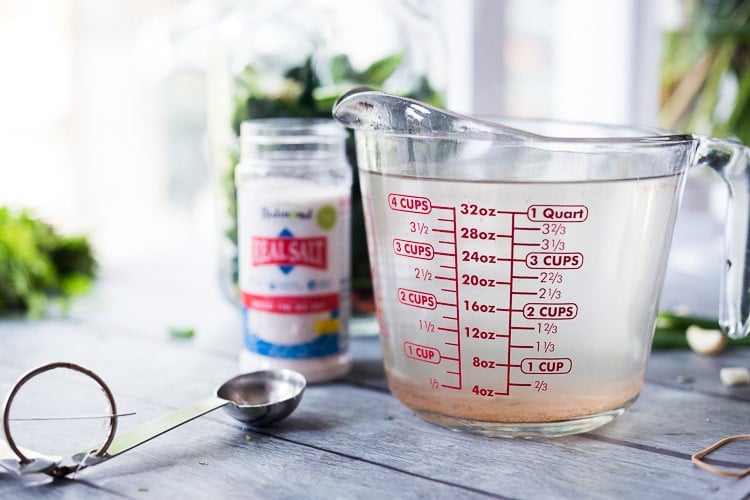
How salt works in fermentation:
- In a nutshell, using the right ratio of salt in fermentation encourages the growth of healthy bacteria while at the same time killing off bad bacteria. You want to be precise when measuring the salt and water in these kinds of recipes.
- Too much salt may kill off ALL of the bacteria -preventing fermentation.
- Too little salt will allow bad bacteria to keep on living. It is a fine balance. 😉
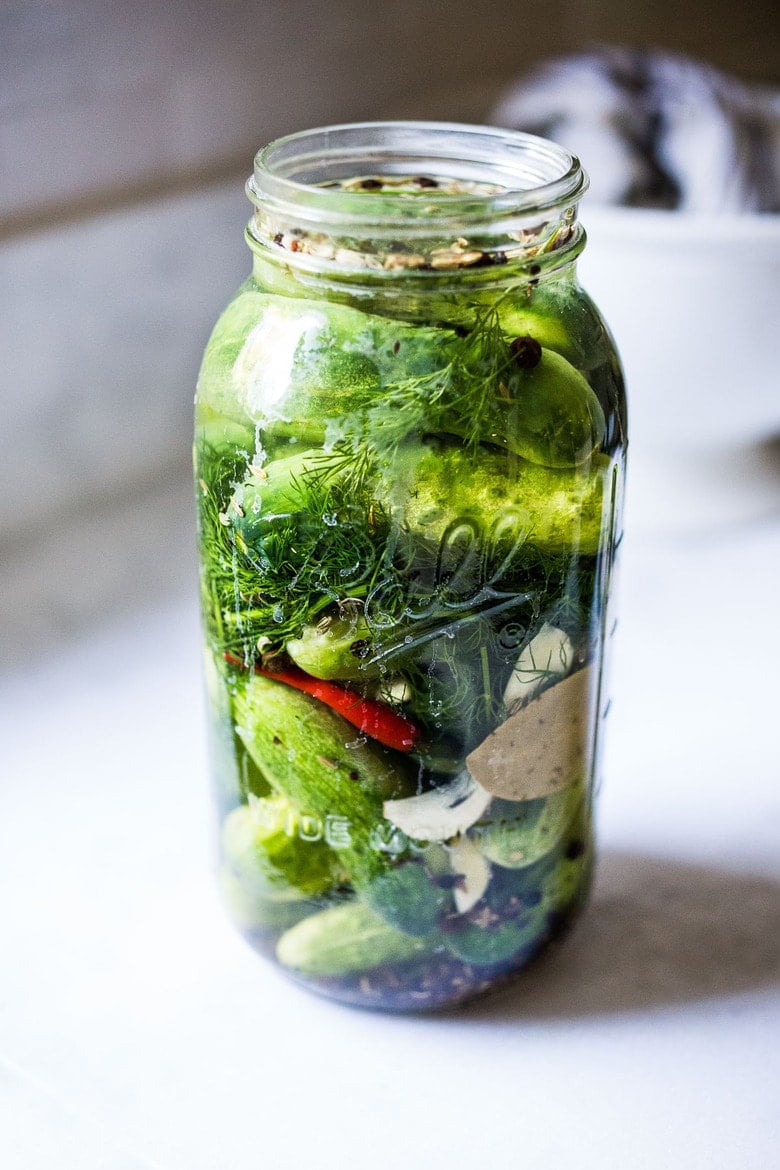
Step 5: Weigh down the cucumbers so they are completely submerged under the liquid, using a couple of fermentation weights, or a small zip lock bag filled with a little water (in a pinch).
MOLD: If the cucumbers or seeds are not submerged under the brine and become exposed to air- they can develop mold, so spoon any floaters out with a slotted spoon. Most seeds should stay submerged.
Step 6: Cover loosely with a lid or towel (to prevent bugs or flies from coming in, and to allow gases to escape) place in a bowl or pan to catch any overflow, and place in a cool dark place for 3-7 days, like the basement. You can also use and airlock lid- which allows air to escape, but nothing to fly in.
Step 7: Check after 2-3 days. Look for signs of life: bubbles/ or cloudy water. A cloudy brine is GOOD. Tap the jar and see if bubbles rise to the top. Check to see if any brine overflowed into the bowl ( both signs of life). This often takes about 3-5 days, I find 4 days is the “sweet spot”, depending on temperature. Cloudy brine is delicious and nutritious!
Step 8: Place the jar in the fridge to further slow the fermentation with a loose lid. They will continue to ferment very slowly and will keep indefinitely.
Expert Tips:
- Ferment at cooler temps (60-70F) to keep pickles crisp. If your home is hot, try placing in a cooler with ice. Take the temp of the brine.
- The longer you ferment them (unrefrigerated), the tangier they will get. But they will also get softer. I like them crisp, but you may want them tangier and softer. You can taste them at any point after you see bubbles.
- Smell: your ferment should smell tangy, garlic and fresh. If you notice anything foul or unpleasant, your ferment may have been contaminated: most commonly by dirty hands, dirty utensils, or a dirty jar.
- If you want to create a “fizzy” brine for drinking, tighten the lid, and burp daily if leaving out. You can tighten the lid in the fridge, but burp weekly. This will create a little pressure and give it some effervescence.
- Anything that touches air- may mold. Always fish out any floating spices with a slotted spoon to prevent this.
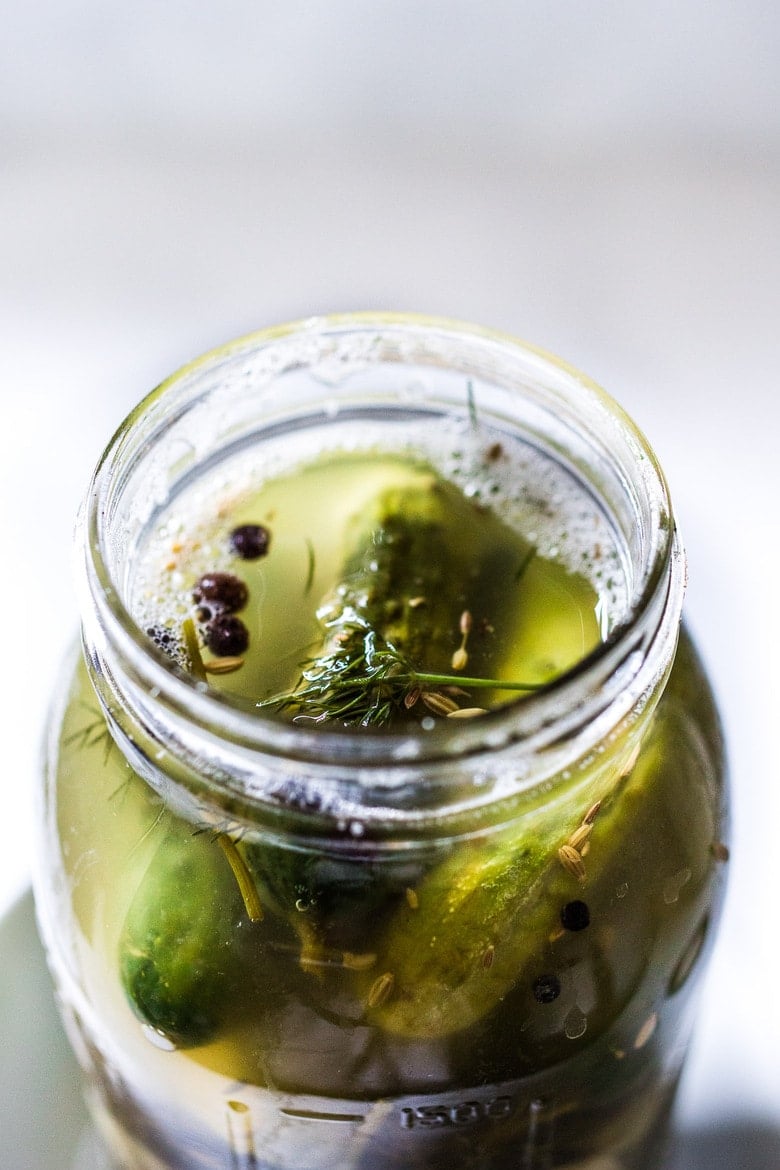
Once they are cold, give them a taste. They should be crunchy and flavorful! The brine is deliciously tangy, salty, and effervescent -so tasty and full of gut-supporting probiotics. The garlic is tasty too! Eat it!
I find myself often drinking shots of the brine! I also make this Gin & Brine Martini!
Let me know how you like this one in the comments below!
xoxoxo
More Favorite Ferments!
- Curtido & Cultured Salvadoran Slaw
- How to make Sauerkraut (Simple Cultured Cabbage)
- Beet and Cabbage Sauerkraut
- Cucumber Kimchi Pickles
- Turmeric Sauerkraut
More from Feasting at Home
How to make Fermented Pickles| 45-sec video
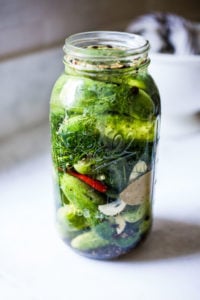
Homemade Pickles with Garlic and Dill
- Prep Time: 4 days
- Total Time: 4 days
- Yield: ½ gallon
- Category: fermented, preserved
- Method: fermented
- Cuisine: American
- Diet: Vegan
Description
How to make Manhattan-style, fermented Dill Pickles! A simple recipe for making the most flavorful, crunchy, tangy, garlic dill pickles with only 15 minutes of hands-on time. Full of healthy, gut-healing probiotics these little guys are perfect as a low-calorie snack, or sliced and added to sandwiches.
Ingredients
- 2- 2 1/2 lbs pickling cucumbers– all similar size ( 5 inches)
- 5 cups filtered water or tap water (that is not overly chlorinated)
- 2 tablespoons fine sea salt or Himalayan salt — or basically one heaping teaspoon fine sea salt (7 grams) per one cup of water, for a 3% brine (see notes)
- 1/4 teaspoon turmeric (optional, adds a “fresh” flavor)
- 1 teaspoon each: fennel seeds, coriander seeds, allspice, peppercorns, dill seeds, mustard seeds, celery seeds- and feel free to add more peppercorns!
- 10-20 garlic cloves, sliced (or double for extra garlicky)
- 1/2 onion, thinly sliced (optional)
- big handful of fresh dill
- 1-3 fresh red chilies – or dried arbol chilies, or add chili flakes (all optional)
- 3-4 bay leaves (or a grape leaf or oakleaf) – these are sources of tannic acid to help them stay crisp.
Instructions
- Prep Cucumbers: Rinse the cucumbers, remove 1/16-inch of the flower end of each cucumber (keeps them from getting soft) and place them in an ice-water bath, to crisp them up (15-30 minutes). Leave them whole.
- Make the brine: Mix salt (2 tablespoons) and 5 cups cold water until dissolved.
- Wash your hands, jar and any utensils. No need to sterilize, just clean!
- Assemble: In a large, clean two-quart mason jar, place all the whole spices into the bottom. Add the dill, garlic and onions or turmeric if using. With clean hands, pack one layer of cucumbers tightly, standing on end, then add the bay leaves, then add the second layer of cucumbers standing on end.
- Press everything down, leaving 1 ½ inches of headroom. Pour the salt water brine over the top and weigh down the cucumbers with fermentation weights so they are submerged under the brine. Remove any spices that may have floated to the surface (which can mold).
- Cover the jar loosely with a lid or with a cloth- basically, the pickles will bubble and you want air to be able to escape.
- Place the jar in a pan or bowl to collect any overflow and leave it in a cool dark place (60-70F) for 2 -3 days (a basement, or lower kitchen cupboard) and check for bubbles or overflow, indicating fermentation. Half sour pickles will take 3-5 days with crisp, white interiors. If is colder than 65F, it may take longer, if hotter, they will ferment faster. Full sour pickles will take 14-21 days (see notes for a stronger saltwater ratio).
- After 2 days, check for signs of life: bubbles, overflow, or clouding. Tap the jar, and see if tiny bubbles rise to the top. I usually ferment for 3-5 days. Longer ferments will yield tangier pickles but will get softer as they ferment, and lose their vibrant color. Up to you. You can taste them at any point after you see bubbles, and ferment longer if you like. The brine will get cloudy as it ferments- this is a good sign! Once you see active bubbles, you can at this point place the jar in the fridge, where it will continue to ferment, but much more slowly. Keep the pickles submerged.
- Once chilled, give them taste. They should be crispy and flavorful with a little tang. (At this point, if you want a tangier or softer pickle, you can absolutely pull them back out again and ferment for a few more days longer if you want.)
- If you like fizzy brine, tighten the lid, burping every week or so or try using an airlock. If you don’t want to think about it, give the lid one loose twist, so it’s on there, but gases can escape.
Notes
If you need more brine, make sure you use the same ratio- 1 heaping teaspoon sea salt per one cup of water.
If using a grape leaf, place it on the side of the jar, then layer the remaining ingredients.
If pickles turn out too soft- it may be due to too warm of temperature during fermentation, or the flower end wasn’t removed (the flower end of the cucumber has enzymes that can soften pickles).
Feel free to use 2, quart-size jars, dividing cucumbers, spices and brine between the jars.
BRINE: This recipe is a 3% salt water brine, which is considered “safe”. It equals 7 grams of salt per one cup of water. I’ve had really good luck with this ratio – and this ratio allows me to drink the brine (like a shot) this is really healthy – full of good gut-supporting bacteria!
If you want a stronger, saltier brine, feel free to go up to 4.5%. For a full sour pickle (14-21 days) use a 4.5% brine.
- 3% ratio = 7 grams salt per 1 cup of water. (1 1/4 teaspoon fine sea salt, per 1 cup water)
- 3.5% Ratio= 9 grams of salt per 1 cup of water. (1 1/2 teaspoon fine sea salt, per 1 cup water)
- 4.5% ratio 10.8 grams of salt per 1 cup of water. (2 teaspoons per cup of water)
Cutting the Cucumbers: I recommend leaving them whole. The texture is much better. After your first successful batch, feel free to experiment.
Nutrition
- Serving Size:
- Calories: 16
- Sugar: 1.3 g
- Sodium: 297.4 mg
- Fat: 0.2 g
- Saturated Fat: 0 g
- Carbohydrates: 3.7 g
- Fiber: 0.5 g
- Protein: 0.7 g
- Cholesterol: 0 mg
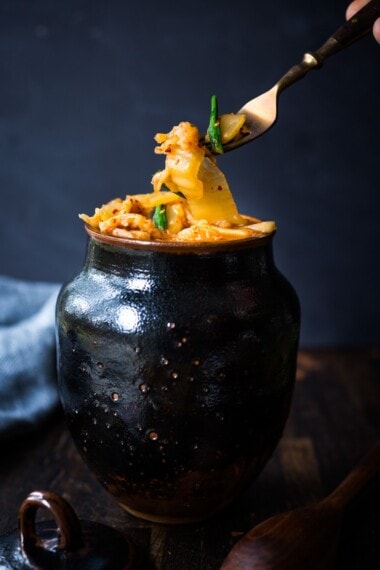
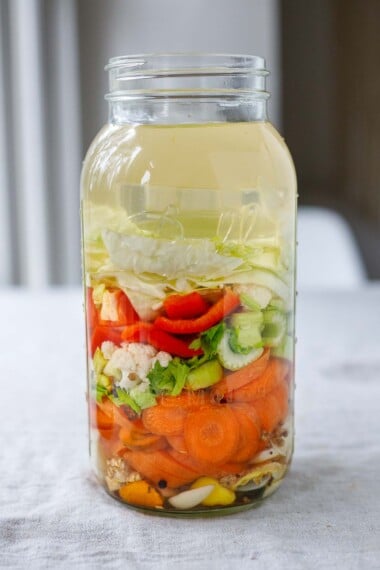
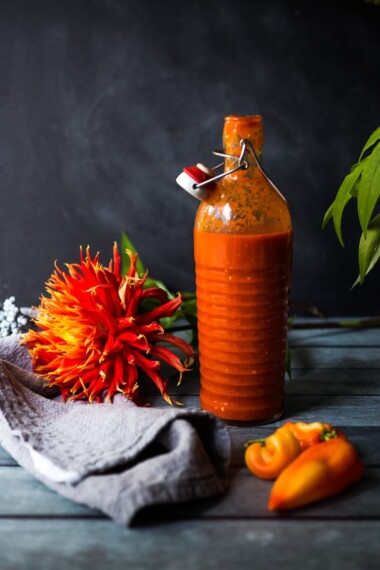
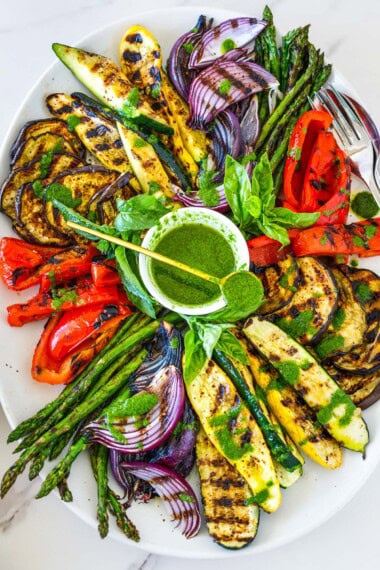



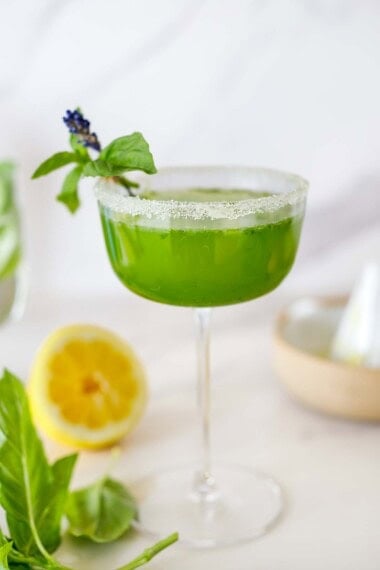
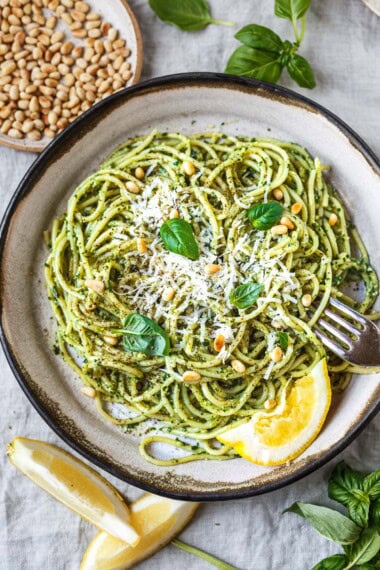
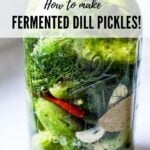
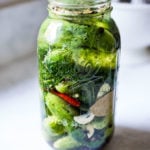
I am a big canning/pickling person, but this is my first attempt at a brine pickle and this recipe is soooo good! Just made my second batch, and plan to make more!
One comment about himalayan pink salt i tried with my second batch. I ended up with a pink residue at the bottom despite much stirring, so either takes forever to dissolve or the “pink” doesn’t dissolve?
Also would this type of fermenting recipe work with other veggies like carrots?
Hi Tria, glad you are enjoying it! I end up with the same pink sediment, and it is totally fine! Yes, works with other veggies- we have a probiotic brine recipe, take peek at that. 🙂
I made many jars of these last summer and we just ate the last two pickles last week. They were transformed, yet always delicious throughout the year. Crunchy and garlicy for months. More sour and more melded flavors in the last months. An unexpected delight was how tasty and crunchy and pickeley the garlic cloves were last week. I used the last pickles in a potato salad for 4th of July, and decided to add some of the pickled dill, garlic, and a splash of the brine to the salad. I can’t bring myself to get rid of the remaining brine and ingredients. It feels like a magical potion. The potato salad was a hit and I am looking forward to making another batch of these pickles this summer once they show up at the farmers market.
What a beautiful telling of the pickling stages, love your awareness and attention to detail Bonnie! Agreed that the brine is truly gold!
Sadly, the big batch of pickles that I made this summer are already gone! I was wondering if I could put other veggies in the pickle brine and ferment for a few days and put back in the fridge? Or is that not a good idea and I should start with fresh brine?
You can use some of the brine in the next batch, but we haven’t tried reusing the whole brine for new pickles, so not sure. There are all kinds of fun uses for the leftover brine: makes a great tonic gut drink (we even have a cocktail recipe!), add to dressings and soups etc.
Thank you for this recipe! Just made these today- first time fermenting veggies and I’m so excited! I don’t have weights yet so hoping the pickles stay submerged, will swirl daily. Do you leave the weights in after putting in fridge? Thanks again!
You can remove the weights once the pickles are fermented and ready to refrigerate.
So once everything is in the fridge, anything can rise to the top and it’s ok?
Yes, should be OK in the fridge.
Few tips for you. I have been doing this all my life. I only use ground pepper and garlic. But anything is fine. I cut both ends of the pickle because sometimes end are just bitter plus it helps to brine faster. I put a layer of the dill on the bottom first then half the garlic and half the ground pepper. After that I put pickles in. The smaller they are the better. Yes, size matters. Once jar is filled (3L jar) I make sure there is about 2 inches or so on top so I put the rest of the dill, garlic and pepper. Then I filled the jar with salty water. I use Norton salt and make brine very salty.
I close the jar with screw on top. Because the dill is not solid all the gasses go there. Once or twice a day I flip the jar for a few seconds.
Now, the pickles are dark green at first so I watch for the color change. As soon as they start turning a little light green which usually takes 3 days I put the jar in the fridge. Cold will stop pickling process. I could store them in the fridge for a year so I get them on sale during the high season.
Thanks for sharing how you do it Eugene!
Hi! So this recipe calls for dill seeds and fresh dill … how much more dill seed would you add if you were out of fresh dill? Thanks!
Hi Christi, I’d add one teaspoon more!
Hi, I have tried the recipe and did everything as instructed but have a couple questions. I let them ferment in my cabinet for four days and no bubbles arrived and the brine is kind of clear. It also appears some salt settled on the bottom. Also I had a pickle escape and grow some mold, to which I promptly removed and inspectors for mold in the water and it seemed clean. What do you think I did wrong and would they be okay to eat?
Oh shoot Solomon! I wonder if the salt wasn’t fully incorporated? Look for any signs of fermentation- bubbles when you tap the jar, or does it smell tangy or sour? I probably would not eat because of the mold- but up to you. 🙂
I’ve been making the full sour 4.5% brine solution pickles with this recipe for awhile now. I absolutely love it. They are absolutely delicious. I won’t buy store pickles anymore. I will do about 5 lbs of these in my crock and they are gone in week in our house. I’ve been buying cucumbers from mexico at the grocery store and they are ok but the local vegetable farm will have them in a few weeks and those are a ton better. Thank you so much for this recipe.
Thanks so much Wade- glad you are enjoying the pickles and appreciate you circling back and rating this for us!
Hi! I’m about to try your amazing recipe! However I have a question can the pickles be transferred into food grade plactic jars for the refrigerator after 3 days?
We don’t advise plastic. Fermented foods continue to culture in the fridge and the plastic may leach chemicals. But do some research, it is ultimately up to you!
I just made your fermented pickles and I LOVE THEM! I’ve never made pickles before and it was so incredibly easy and the pickles are insanely delicious! My only question is do I need to be concerned with keeping just the pickles under the brine or all of the ingredients under the brine? I used dill and little bits of it (together with some fennel seeds) keep floating to the top. How vigilant should I be? Thanks for all that you do – your website is a constant resource for me.
They should be ok especially if you swirl the brine around every day. You could also top with a cabbage leaf and then set a ferment weight on top.
Once the pickles are finished do you reuse the brine or can you?
Hi Lindsay- you can use some of the brine in the next batch, but I havnt tried reusing the whole brine for new pickles, so I am not sure. I will have to try this once pickling cucumbers are in season.
This was so helpful. My pickles always came out soft so I stopped trying. One try cutting the blossoms… I forgot to ice bath them and they were still good, thank you. I’m doing this with jalapenos and banana peppers now. Will they also last indefinitely? How about other veggies?
Great to hear! Yes, cutting the blossom end helps. Yes you can ferment most veggies- and if they ferment properly, they should last. 🙂 Check out our Gut shot recipe.
Your pickles come out soft because you kept them fermenting too long. Look at the color, as soon as it turns a little yellow in 3 days or so you are done. Put them in the fridge right away to stop pickling.
These pickles are so amazing! And keep a long time! However, when I made them last fall, a pickle floated to the top when they were in the fridge without my realizing it. When I looked at them, there was a white/cream colored solid layer that was so firm, I could pull it out in one piece–almost like plastic. I took it out and weighted down the pickles properly. They got shoved to the back of the fridge and ignored. When I got it out today, there are thick slimey white strings with some small black sections in it as well. Is this likely mold and do I need to throw out the whole gallon? Do I dare taste one of the pickles? Thanks!
Hi Anne, shoot! That sounds like mold to me. I am really mold averse so I personally would not try them.
Hi there! I’m excited to try these!
How long will they last in the refrigerator (providing we don’t eat them all in one sitting 😉?)
6 months or longer!
all of my spices are floating to the top. I’m so scared they’re going to mold as I can’t remove them all. Any suggestions?
You can put a big cabbage leaf in the top of the jar- wedge it in so it creates a lid. To keep it all under the brine you can then weight this down with a glass weight (special fermenting weights). Or instead of the cabbage you can use a plastic bag filled with water (not sure if these leaches plastic into the ferment?).
This was my first time making my own pickles and they were amazing! Tasted exactly like my Ukrainian baba used to make. First bite literally brought a tear to my eye. That’s how good they were! Did about a dozen whole kirbys and cut some large cucumbers I had that needed to get eaten into spears. Definitely recommend leaving them whole and just trimming the tip. The whole ones stayed super crispy. The cut spears had the same great flavor but ended up too soft. I wound up chopping most of the spears up, mixing them with sour cream, whipped cream cheese, a splash of buttermilk and turning them into dill pickle dip.
Pickles are long gone but still have some brine left that I will experiment with. Going to attempt to dilute it a bit and use it as a substitute for chicken stock in a baked rice dish I make regularly for my family.
The brine also makes a great olive brine substitute in a dirty martini. Definitely making another, much larger batch very soon!
Love all of this! Food carries such memories. Dill pickle dip- I want some! We have a gin + brine cocktail on the site! Pickle juice is amazing, and full of goodness. Thanks so much for the awesome share and review:)!
My first comment here, although I’ve made a lot of your recipies, always a success. But these was my first lactofermented attempt and after three days the pickles taste fantastic!! I’m thrilled and motivated to continue to experiment with more fermentation! Next will be your new probiotic gut shot. I know that with your recipies and tips there’s no way to be wrong.
Thanks a lot from Spain, Sylvia!!!
Thanks Silvia! Appreciate this! Let us know how you like the Gut Shot.
Why do some people put sugar and you dont?
Mainly it is just for flavor- you can add if you prefer.
Hi sounds delicious but do you use cold warm or hot water?
Hi Lana, use cold water or room temp.
Thanks for the recipe. Can I do libg fermentation with 3% salt? I like my pickles soft but also want to be able to drink the juice.
Yes, this should still work!
Can you slice the cucumbers length ways or coin them to get them to fit better in the jar?
These turn out much better left whole. But feel free to experiment Chris! 🙂
Here in Switzerland, the only pickles available are vinegar-y and simply awful! I’ve been pigging out on “real” dill pickles at a spa we go to once a year overseas and this time one of the chefs kindly shared a recipe very much like yours. No vinegar and no “baths.” Of course, there weren’t any wisdoms in their translation so I might have been a little smarter (and will be, next time). I used a sealable jar and had filled the liquid to the top as they instructed. This morning I realized (day 1.5) the brine was going to burst the jar. Good to know the gas was a sign it was doing what it should, but we drained about an inch out just to be safe. Who knew the jar didn’t need to be closed tightly? I also used regular salt and didn’t take care to trim all the stems – nor did I put them in an ice bath. Live and learn? But I’m confident, thanks to you, I’ll finally enjoy the real thing at home. Your tips are more than helpful, as are some of your seasoning add-ons. Good thing my husband isn’t a pickle lover as I suspect there won’t be enough for two!! Thanks very, very much!! P.S. The brine that overflowed was incredible! I couldn’t resist trying.
I love the brine too! So tasty. Enjoy the pickles. 🙂
Hi there. Could you tell me the brand of the food processor that you made the chili paste in? Thanks.
Hi Lorraine-I use a Cuisinart food processor.
Ok so where to start…. I decided to make these and have zero experience making pickles but I can follow directions so I just did it, exactly as written. After four days in my basement I checked them. Everything looked good so I put them in the fridge to try the next day when they are good and cold. I ate one and was immediately taken aback by how crunchy they were and then noticed how pleasant the garlicky, salty, dilly the brine was. I had to have another. Soon the jar was empty and I’m still craving another. I’ve since ordered a 3 gallon crock and can’t wait to make a huge batch of these. They are simply amazing.
Haha…Amazing Wade! So happy to hear it was a success.
Our mom always bought Strub pickles, naturally fermented, they are still sold in the refrigerator section of grocery stores and are around $ 12 per 1 liter jar. Thank you for the recipe!
Oh that is so neat!